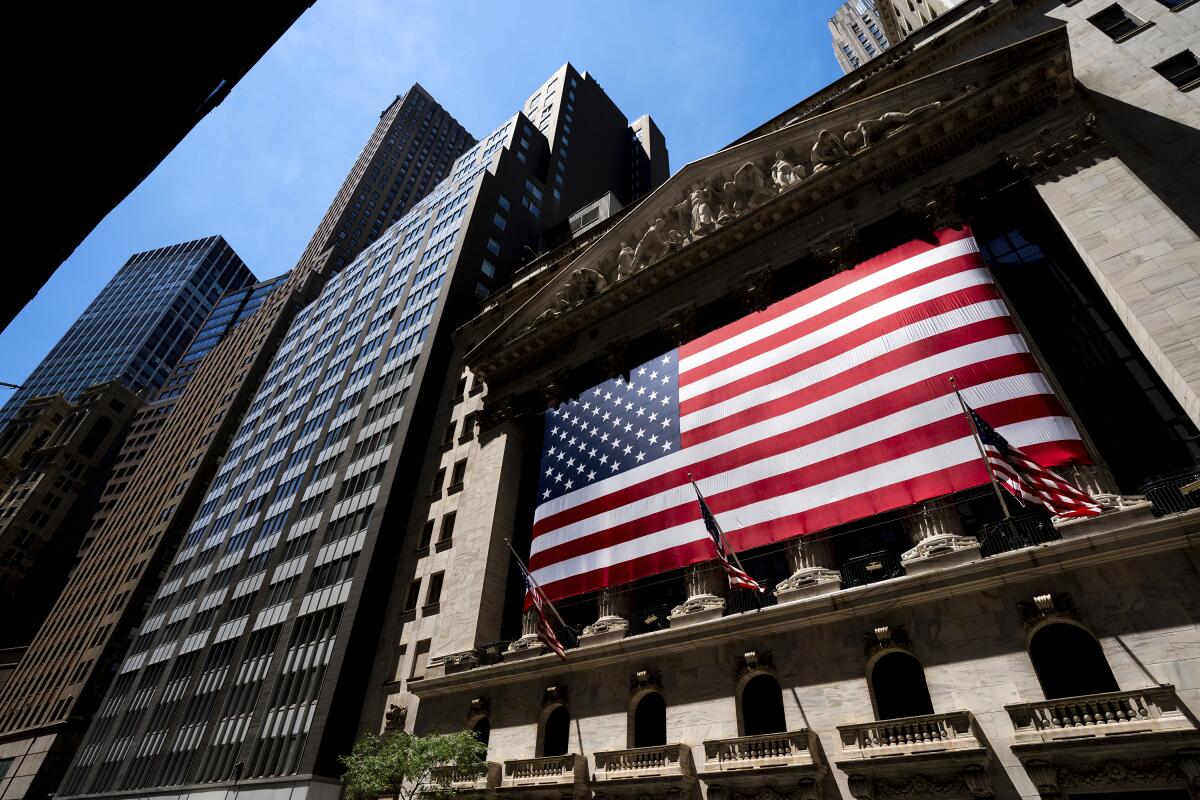Stocks fall again on Wall Street, extending recent losses

- Share via
Stocks closed broadly lower on Wall Street on Tuesday, extending the market’s recent string of losses as traders ponder the Federal Reserve’s next moves in its campaign to cool stubbornly hot inflation.
The Standard & Poor’s 500 index fell 1.4%, its fourth straight drop. The Dow Jones industrial average fell 1% and the Nasdaq composite lost 2%.
Technology stocks, communication companies and retailers had some of the biggest losses. Apple fell 2.5%, Disney slid 3.8% and AutoZone dropped 2.8%.
Small-company stocks also fell, pulling the Russell 2000 index 1.5% lower. The major indexes are on pace for a weekly loss after posting two straight weekly gains.
Bond yields mostly held steady. The yield on the 10-year Treasury slid to 3.52% from 3.58% late Monday.
European markets ended mostly lower and Asian markets closed mixed.
Several companies made big moves after financial updates and buyout announcements.
Utility NRG Energy slumped 15.1% after announcing that it is spending $2.8 billion in cash and assuming $2.4 billion in debt to buy Vivint Smart Home.
Jewelry company Signet vaulted 20.2% after raising its profit and revenue forecasts for the year.
About 80% of stocks in the S&P 500 fell, leaving the benchmark index down 57.58 points at 3,941.26. The Dow dropped 350.76 points to 33,596.34, while the tech-heavy Nasdaq lost 225.05 points to close at 11,014.89.
The Russell 2000 slid 27.65 points to 1,812.58.
The broader market’s drop comes a day after stocks pulled back as stronger-than-expected readings on the economy raised worries that the Fed has a ways to go in getting inflation under control. The Fed is doing that by intentionally slowing the economy with higher interest rates.
“We’ve been in this period where investors have been anticipating now that the Fed will back off pretty soon, they’ll pause soon and probably even start cutting rates in the back half of 2023,” said Bill Merz, head of capital market research at U.S. Bank Wealth Management.
“And then when we get the occasional robust jobs report and inflation report that makes it clear that inflation remains quite problematic and it’s not decelerating as quickly as anyone would like,” Merz said.
Investors are closely watching economic data and company announcements to get a better sense of how the economy is handling stubbornly hot inflation. They are also trying to determine whether inflation is easing at a pace that will allow the Fed to ease up on interest rate increases. The Fed’s policy risks hitting the brakes on the economy too hard and sending it into a recession.
The Fed is meeting next week and is expected to raise interest rates by half a percentage point. It has raised its benchmark rate six times since March, driving it to a range of 3.75% to 4%, the highest in 15 years. Wall Street expects the benchmark rate to reach a peak range of 5% to 5.25% by the middle of 2023.
Wall Street will get a weekly update on unemployment claims Thursday. The job market has been one of the stronger pockets in the economy.
Investors will get important updates on inflation and how consumers are dealing with high prices later in the week.
On Friday, the government will release its November report on producer prices. That will give investors more insight into how inflation is affecting businesses.
The University of Michigan will release its December survey on consumer sentiment Friday.
With growing concern about a recession, Fitch Ratings revised its forecasts for world economic growth downward to reflect the Fed’s and other central banks’ interest rate hikes.
The ratings agency’s Global Economic Outlook report estimated global growth at 1.4% in 2023, revised down from 1.7% in its September forecast. It put U.S. growth in 2023 at 0.2%, down from 0.5%, as the pace of monetary policy tightening increases.
AP writers Elaine Kurtenbach and Matt Ott contributed to this report.
More to Read
Inside the business of entertainment
The Wide Shot brings you news, analysis and insights on everything from streaming wars to production — and what it all means for the future.
You may occasionally receive promotional content from the Los Angeles Times.










